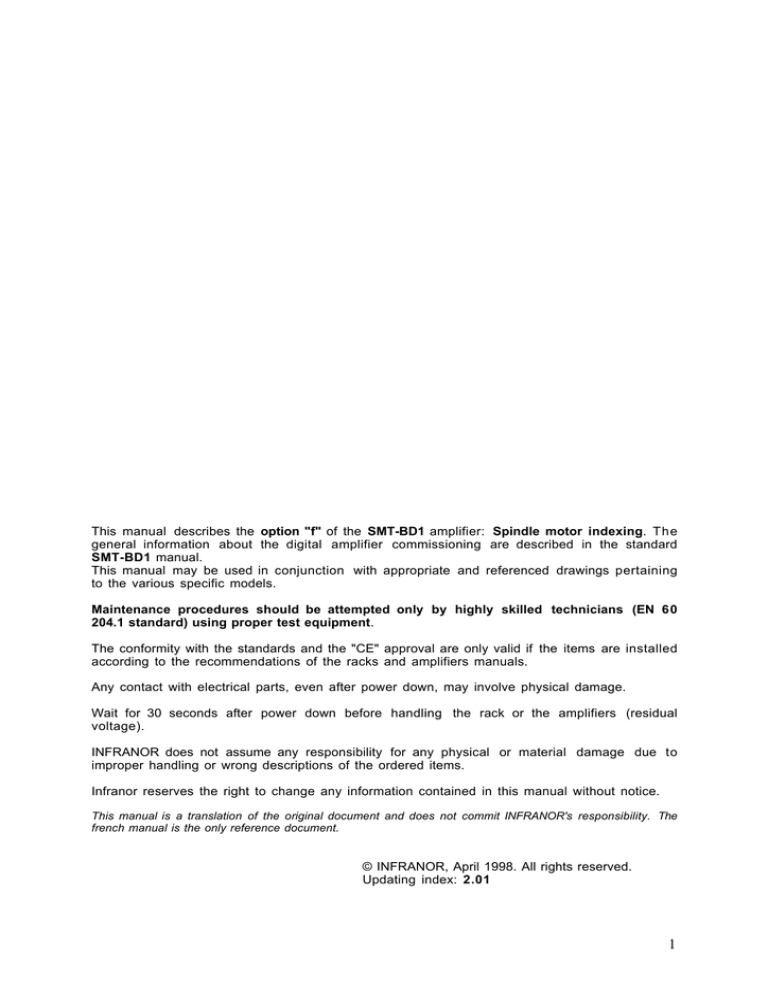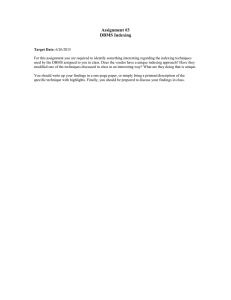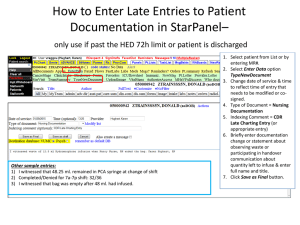
This manual describes the option "f" of the SMT-BD1 amplifier: Spindle motor indexing. The
general information about the digital amplifier commissioning are described in the standard
SMT-BD1 manual.
This manual may be used in conjunction with appropriate and referenced drawings pertaining
to the various specific models.
Maintenance procedures should be attempted only by highly skilled technicians (EN 60
204.1 standard) using proper test equipment.
The conformity with the standards and the "CE" approval are only valid if the items are installed
according to the recommendations of the racks and amplifiers manuals.
Any contact with electrical parts, even after power down, may involve physical damage.
Wait for 30 seconds after power down before handling the rack or the amplifiers (residual
voltage).
INFRANOR does not assume any responsibility for any physical or material damage due to
improper handling or wrong descriptions of the ordered items.
Infranor reserves the right to change any information contained in this manual without notice.
This manual is a translation of the original document and does not commit INFRANOR's responsibility. The
french manual is the only reference document.
© INFRANOR, April 1998. All rights reserved.
Updating index: 2.01
1
2
OPTION "f"
SPINDLE MOTOR INDEXING
WITH THE SMT-BD1/f AMPLIFIER
3
CONTENTS
CHAPTER 1 - GENERAL DESCRIPTION ......................................................................................5
CHAPTER 2 - SPECIFICATIONS...................................................................................................6
1 - TECHNICAL DATAS ............................................................................................................ .6
2 - AMPLIFIER BLOCK DIAGRAM ..............................................................................................7
CHAPTER 3 - INPUTS - OUTPUTS ................................................................................................8
1 - X2 POSITION CONNECTOR..................................................................................................8
1.1 - Pins references.................................................................................................................8
1.2 - SPECIFICATION OF THE LOGIC INPUTS / OUTPUTS .......................................................9
2 - X3 TEST CONNECTOR ........................................................................................................9
CHAPTER 4 - CONNECTIONS .................................................................................................... 10
1 - CONNECTION DIAGRAM .................................................................................................... 10
2 - MANDATORY WIRING........................................................................................................10
CHAPTER 5 - ADJUSTABLE PARAMETERS............................................................................... 11
1 - OPERATION MODE.............................................................................................................11
2 - APPLICATION PARAMETERS ............................................................................................. 12
3 - POSITION REGULATOR PARAMETERS .............................................................................. 12
4 - INDEXING POSITIONS.........................................................................................................13
CHAPTER 6 - COMMISSIONING ................................................................................................ 14
1 - CHECKING THE CONFIGURATION......................................................................................14
2 - POWERING......................................................................................................................... 14
3 - START AND ADJUSTMENT................................................................................................ 14
4 - PROGRAMMATION OF THE INDEXING POSITIONS............................................................. 14
CHAPTER 7 - FAULT FINDING................................................................................................... 16
1 - LOUD CRACKLING NOISES IN THE MOTOR AT STANDSTILL ............................................16
2 - LOUD NOISE IN THE MOTOR AT STANDSTILL AND WHEN RUNNING ...............................16
3 - MOTOR POSITION OSCILLATION AT STANDSTILL............................................................ 16
CHAPTER 8 - APPENDIX ............................................................................................................17
LOCATION DIAGRAM OF THE HARDWARE OPTIONS............................................................. 17
4
SMT-BD1/f • Contents
CHAPTER 1 - GENERAL DESCRIPTION
Applications with spindle motor indexing require the SMT-I2-BD1 daughter board on the SMT-BD1 amplifier and
the firmware memory version X.XF. In this configuration, the SMT-BD1/f amplifier ensures the positioning of
the spindle motor shaft during the tool exchange, according four programmable positions. The spindle motor
must be equipped with a one pole pair resolver (speed 1) for the absolute definition of the four indexing
positions on one shaft revolution. The logic inputs and outputs which are necessary for this kind of operation,
are wired on the amplifier X2 connector as shown below.
Both logic inputs IDX0 and IDX1 allow the selection of the desired indexing position among the four
programmed positions. When the logic input STOP is activated, the motor shaft stops on the position
previously selected.
The programmation of the four indexing positions can be performed in teach mode by moving the motor shaft
manually or by using the logic inputs JOG+ et JOG- of the X2 connector. Pushing the Offset push button of
the amplifier front panel allows to store the present indexing position into the amplifier EEPROM. The four
indexing positions can also be programmed by means of the BPCW software and stored in the amplifier.
During the amplifier operation in speed mode, the logic output VEL is enabled when the motor speed is
equal to the speed input command.
During the amplifier operation in indexing mode, the logic output POS is enabled when the motor shaft is on
the indexing position.
SMT-BD1/f • Chapter 1: General description
5
CHAPTER 2 - SPECIFICATIONS
1 - TECHNICAL DATAS
Logic inputs
IDX0 : Axis indexing selection among 4
IDX1 : Axis indexing selection among 4
STOP : Stop on selected indexing
JOG+ : Indexing displacement in positive direction
JOG- : Indexing displacement in negative direction
Optocoupled inputs : from 5 V to 24 V
Logic outputs
VEL : Indication "speed input command is reached"
POS : Indication "indexing position is reached"
Optocoupled outputs Imax 5 mA
Drive position repetability
1 motor shaft revolution/65536 (resolver speed 1)
Drive position accuracy (*)
8 Arc mins as standard
(2 arc mins optional)
(*) The total accuracy must take into account the resolver accuracy.
Speed / position regulator
Sampling period of 0,5 ms
Integrator antisaturation system
Adjustable digital gains
Antiresonance filter
Speed / position bandwidth
Cut-off frequency for 45° phase shift
Selectable : 50 Hz, 75 Hz, 100 Hz
6
SMT-BD1/f • Chapter 2: Specifications
2 - AMPLIFIER BLOCK DIAGRAM
Resolver
MOTOR
SMT-I2-BD1
option board
-UP
X1
5/9
X2
VEL
18/23
8/23
3/4
5/6
1/2
4/8
Ref
3/7
SIN
1/2
COS
CA
CB Encoder
CZ output
Resolver
conversion
Resolver
oscillator
ID
U
IQ
V
W
DC BUS
T¡ mot
Logic
POS outputs
+UP
PR10
Imes
GT
PR8
Current
monitor
Pmes
d / dt
IDX0
9/23
IDX1
19/23
22/23 STOP
JOG+
20/23
JOG21/23
Indexing
input
Pref
18/19
AOK
Vmes
Position
loop
Vector
control
Speed
loop
fdc
Current
loops
PWM
1/26
I2t
IDC
X4
Vref
3/15
ILIM
+15V
Analog
input
Enable
Analog
input
EEPROM
Power fault
CV
fc+ fc- CV0
P err
Vmes
Vref
IQ
ID
Imes
Idc
16/17
Ramp
0V
fc+
fcCV0
CI
Enable
RESET
1/6
X3
CV
GT
3
4
Serial
interface
Selectable
outputs
2
5
5
2/3
7/8
6/9
X5
SMT-BD1/f • Chapter 2: Specifications
Enable
29
-15V
64/32
· ENABLE
T¡ mot
1
14
7
4
20
13
Logic
supplies
Protections
AOK
X X X XX X
ERROR SYS ON
7
CHAPTER 3 - INPUTS - OUTPUTS
1 - X2 POSITION CONNECTOR
1.1 - PINS REFERENCES
PIN
1
I/O
REMARK
CZ/
O
CZ
CA/
CA
CB/
CB
0V
Reserved
Reserved
O
O
O
O
O
9
19
22
20
21
IDX0
IDX1
STOP
JOG+
JOG-
I
I
I
I
I
Logic input IDX0 : Indexing selection
Logic input IDX1 : Indexing selection
Logic input STOP : Stop on indexing
Logic input JOG+: Indexing displacement pos. direction
Logic input JOG- : Indexing displacement neg. direction
18
8
VEL
POS
O
O
Logic output VEL : Speed input command is reached
Logic output POS : Indexing position is reached
23
0 V I/O
24
25
+5V
0V
2
3
4
5
6
7,10,11
12,13,14
15,16,17
8
FUNCTION
Motor encoder
current 20 mA)
Motor encoder
Motor encoder
Motor encoder
Motor encoder
Motor encoder
GND
Reserved
Reserved
output of the marker pulse Z/ (5 V max.
output
output
output
output
output
of the marker pulse
channel A/ (5 V max. current 20 mA)
channel A
channel B/ (5 V max. current 20 mA)
channel B
0 Volt logic inputs and outputs
O
+/- 5 % 300 mA available with jumper 5 V closed
SMT-BD1/f • Chapter 3: Inputs - Outputs
1.2 - SPECIFICATION OF THE LOGIC INPUTS / OUTPUTS
The IDX0, IDX1, STOP, JOG+ and JOG- are optocoupled and operate in positive logic according to the
diagram shown below. The input voltage corresponding to the level 1 is between 5 and 24 V.
The VEL and POS outputs are "open collector" and "optocoupled" outputs. The transistor is inhibited as long
as the output is not activated. The traditional application scheme is shown below. The maximum output
current is 5 mA.
2 - X3 TEST CONNECTOR
PIN
1-6
2
3
4
5
FUNCTION
REMARK
0V
DAC 1 ouput
Speed input command CV
Speed monitor GT
DAC 2 output
±10 V resolution 8 bits, linearity: 2 % (IDC, Imon., ID, IQ,
Vref, Vmon., Pos err) *
±10 V for ± max. speed
±8 V for ±14 000 rpm
±10 V resolution 8 bits, linearity: 2 % (IDC, Imon., ID, IQ,
Vref, Vmon., Pos err)*
* See manual "BPCW Options", part 2 "Digital oscilloscope".
Linearity = 10 % on logic boards 01612A, 01612B and 01612C.
SMT-BD1/f • Chapter 3: Inputs - Outputs
9
CHAPTER 4 - CONNECTIONS
1 - CONNECTION DIAGRAM
2 - MANDATORY WIRING
For the analogue input command signal CV, use a shielded twisted pair cable with a 360° shield connection
ensured by means of the metal plated connectors at both cable ends (see standard manual "SMT-BD1 digital
drive, Chapter 8, part 6). The amplifier 0 Volt (X4, pin 15) MUST be connected to the NC (Gnd).
The input command wiring (CV) must be made according to the polarities between both NC and amplifier (CV+
on "diff. high" of the NC).
10
SMT-BD1/f • Chapter 4: Connections
CHAPTER 5 - ADJUSTABLE PARAMETERS
The parameters concerning spindle drive applications with axis indexing are accessible via the submenus
Spindle indexing and Indexing positions of the menu Advanced functions in the BPCW software version
2.0. and greater.
1 - OPERATION MODE
When the logic input STOP is not activated, the operation in speed mode with a PI or PI2 mode is the same
as the one of the standard amplifier. The logic output VEL indicates that the motor speed has reached the
value of its input command with the accuracy defined by the parameter Velocity accuracy.
When the logic input STOP is activated, the motor decelerates according to the ramp defined by the
parameter Accel/Decel Time. It then moves in the same direction until the indexing position selected by
means of the logic inputs IDX0 and IDX1 according to the speed value defined by the parameter Indexing
speed. The motor position is then controlled at this indexing position by a PIV + feedforward regulator. The
logic output POS indicates that the motor has reached the indexing position with the accuracy defined by the
parameter Position error.
SMT-BD1/f • Chapter 5: Adjustable parameters
11
2 - APPLICATION PARAMETERS
The following parameters are accessible via the submenu Spindle indexing in the menu Advanced functions
from the BPCW software 2.0 on.
The parameter Position error defines the tolerance on the position error for the activation of the POS output
in the axis indexing mode. When the logic input STOP is activated and when the error between both motor
and indexing position is below this value, the POS output is activated in order to indicate that the motor has
reached the indexing position. This parameter is expressed in mechanical degrees on the motor shaft (with a
one pole pair resolver "speed 1"). The adjustment range is between 0 and 180°.
The parameter Velocity accuracy defines the motor speed accuracy in % for the activation of the VEL
output in speed control (logic input STOP disabled). At speeds higher than 200 rpm and when the error
between the motor speed and its input command remains within the tolerance (speed input command x
Velocity accuracy), the VEL output is activated in order to indicate that the motor has reached its input
command speed. At speeds lower than 200 rpm, the VEL output is not activated. This parameter is
expressed in %; the adjustment range is between 1 % and 50 %.
The parameter Indexing speed defines the motor rotation speed during the indexing positioning phase, when
the logic input STOP is activated. The motor decelerates according to the ramp defined by the parameter
Accel/Decel Time. The displacement until the indexing position is then made in the same direction according
to the trapezoidal curve shown below. The deceleration and acceleration times are automatically calculated in
order to avoid a current saturation in the amplifier. This parameter is expressed in rpm; the adjustment range
is between 2 rpm and the value of the parameter Maximum speed.
3 - POSITION REGULATOR PARAMETERS
The structure of the regulator used in the indexing mode with the logic input STOP activated is shown below.
The function Controller parameters of the menu Advanced functions in the BPCW software allows the
access to all regulator parameters.
The parameter Speed error low pass filter defines the cut-off frequency a - 3 db (Fev) of the first order filter
acting on the speed error. The value of this parameter depends on the selected bandwidth.
12
SMT-BD1/f • Chapter 5: Adjustable parameters
The parameter Proportional speed gain defines the proportional gain (KP2) of the regulator acting on the
speed error. The adjustment range is between 0 and 4 095.
The parameter Integral 1 speed gain defines the first integral gain (KI) of the regulator acting on the speed
error. The adusjtment range is between 0 and 255.
The parameter Proportional position gain defines the proportional gain acting on the position error (KP1).
The adjustment range is between 0 and 1.
The parameter Feedforward position gain defines the amplitude of the anticipating term (KF) corresponding
to the speed input command (derivation of the position input command). This anticipating term allows to
reduce the following error during the motor acceleration and deceleration phases. The adjustment range is
between 0 and 1.
All these gain parameters are automatically calculated during the execution of the AUTOTUNING function.
4 - INDEXING POSITIONS
The four indexing position values are accessible via the submenu Indexing positions of the menu Advanced
functions in the BPCW software version 2.0 and greater. The value range is between 0 and 360°.
SMT-BD1/f • Chapter 5: Adjustable parameters
13
CHAPTER 6 - COMMISSIONING
1 - CHECKING THE CONFIGURATION
Check the amplifier standard configuration as described in Chapter 6 of the standard SMT-BD1 manual.
Check for the presence of the SMT-I2-BD1 daughter board between both logic and power boards (see chapter
8 (Appendix): Location diagram of the hardware options).
Check for the X.XF firmware memory version.
Check that the jumpers E and S of the amplifier logic board are open (see chapter 8 (Appendix): Location
diagram of the hardware options).
2 - POWERING
Turn on the amplifier as described in Chapter 6 of the standard SMT-BD1 manual.
3 - START AND ADJUSTMENT
Start the amplifier commissioning and adjustment as described in chapter 6 of the standard SMT-BD1 manual
by selecting a PI or PI2 speed regulator in the BPCW software before executing the AUTO-TUNING function in
the CONTROLLER module.
In case of loud noise in the motor at standstill and when running, check the transmission rigidity between
motor and load (backlashes and elasticities in gearings and couplings).
If necessary, renew the AUTO-TUNING procedure by choosing a lower bandwidth (Bandwidth = Medium or
Low). If the problem remains, renew the AUTO-TUNING procedure by activating the antiresonance filter
(Filter = Antiresonance). The antiresonance filter is accessible from the BPCW software version 2.6 and the
amplifier EPROM version 5.7.
Display the module Spindle motor indexation accessible in the menu Advanced functions in the BPCW
software version 2.0 and greater.
Initialize the parameter Indexing speed at a low value (i.e. 50 rpm) if you want a soft indexing positioning.
Initialize the parameters Position error and Velocity accuracy according to the application.
4 - PROGRAMMATION OF THE INDEXING POSITIONS
A. Programmation in teach mode
Select the code of the first indexing position on the logic inputs IDX0 and IDX1.
If a positioning on the index without overshooting is required, set the Feedforward gain parameter at zero (in
the Controller parameters window).
Activate the logic input STOP :
- when the amplifier input ENABLE is activated, the motor will be controlled at the indexing position presently
stored in the amplifier EEPROM. Then, use the inputs JOG+ and JOG- for moving the motor shaft until the
desired indexing position.
- when the amplifier input ENABLE is not activated, manually move the motor shaft until the desired indexing
position.
When the motor shaft is on the desired position, push the amplifier push button OFFSET to make the
acquisition of the indexing position and store its value into the amplifier EEPROM.
14
SMT-BD1/f • Chapter 6: Commissioning
Disable the logic input STOP.
Select the next indexing position code on the logic inputs IDX0 and IDX1.
Activate the logic input STOP and use the same procedure as for the first indexing position.
B. Programmation with the BPCW software (version 2.0 and greater)
Select the submenu Indexing positions in the menu Advanced functions.
Set the four indexing position values and click on "OK".
Execute the command Store parameters to EEPROM before quitting the BPCW software.
SMT-BD1/f • Chapter 6: Commissioning
15
CHAPTER 7 - FAULT FINDING
1 - LOUD CRACKLING NOISES IN THE MOTOR AT STANDSTILL
Check that the Motor-Amplifiers-PLC ground connections answer the requirements of chapter 4.
Check that the wiring of the speed input command answer the requirements of chapter 4.
2 - LOUD NOISE IN THE MOTOR AT STANDSTILL AND WHEN RUNNING
Check for the rigidity of the mechanical coupling between motor and load (backlashes and elasticities in the
gearboxes and couplings).
Execute the AUTO-TUNING function again by selecting a lower bandwidth (Medium or Low).
If the problem remains, renew the AUTO-TUNING procedure by activating the antiresonance
filter (Filter = Antiresonance). The antiresonance filter is accessible from the BPCW software
version 2.6 and the amplifier EPROM version 5.7.
3 - MOTOR POSITION OSCILLATION AT STANDSTILL
Check for the rigidity of the mechanical coupling between motor and load (backlashes and elasticities in the
gearboxes and couplings).
Reduce the value of the parameter Proportional position gain in the submenu Controller parameters
accessible via the menu Advanced functions.
16
SMT-BD1/f • Chapter 7: Fault finding
CHAPTER 8 - APPENDIX
LOCATION DIAGRAM OF THE HARDWARE OPTIONS
SMT-BD1/f • Chapter 8: Appendix
17


